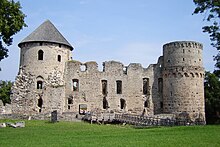Battle of Wenden (1578)
| Battle of Wenden (1578) | |||||||
|---|---|---|---|---|---|---|---|
| Part of Livonian War | |||||||
 Cēsis (Wenden) Castle today |
|||||||
|
|||||||
| Belligerents | |||||||
|
|
|
||||||
| Commanders and leaders | |||||||
|
Andrzej Sapieha, Göran Boije |
Ivan Galitzin | ||||||
| Strength | |||||||
| 4,000–6,000 | 18,000–22,000 (Livonian claim) | ||||||
| Casualties and losses | |||||||
| about 400 men |
6,280 killed (inflated Livonian claim) |
||||||
6,280 killed (inflated Livonian claim)
3,000 captured
1,720 dispersed
20–30 artillery pieces
The Battles of Wenden were a series of battles for control of the stronghold of Wenden (Cēsis, Kiesia, Võnnu), in present-day Latvia, fought during the Livonian War in 1577 and 1578. Magnus of Livonia besieged the town in August 1577, but was deposed and replaced by Russian forces under tsar Ivan IV, who eventually sacked the town and castle in what became a symbolic victory. Polish forces, however, re-captured the stronghold in November, and beat back a Russian counter-attack in February 1578.
In October 1578, the Russian army again laid siege to the town, but was destroyed by a smaller Swedish–German–Polish relief force. This marked the turning point in the Livonian War, shifting the initiative from the Tsardom of Russia to Sweden and the Polish–Lithuanian Commonwealth. It also marked the end of the Kingdom of Livonia, which collapsed when Magnus retired to Courland.
In 1570 and 1571, Ivan IV "the Terrible" of Russia faced internal disputes, culminating in the slaughter of Novgorod's inhabitants and the burning of Moscow by the Crimean tartars. Yet, he was able to recover and resume his campaigns in the Livonian War in 1572.A Swedish counter-offensive in 1574 failed. Ivan IV had introduced a new strategy, relying on tens of thousands of his troops, Cossacks and tartars to achieve a superiority over his adversaries. Unlike the latter, he used a large number of native troops instead of a few thousand professional mercenaries.Swedish forces were besieged in Reval (Tallinn), Danish Estonia was raided, and so was central Livonia as far as Dünaburg (Daugavpils), since 1561 formally under Polish suzerainty. The conquered territories submitted to Ivan or his vassal, Duke Magnus of the House of Oldenburg, who was declared as king of Livonia in 1570.
...
Wikipedia
